If you’ve landed on this page, the jig is up: You want bigger (or stronger) arms. We understand — at BarBend, we’re just as devoted to building up our arms as you are. Training your arms with weights can improve your confidence, sculpt and shape the muscles, and help you perform better in all manner of physical activity.
But with so many arm exercises out there, how can you know which ones are worth your time? By arming yourself with the movements in this guide. These are our picks for the best all-around arm exercises you can do … plus what to do with them:
10 Best Arm Exercises
- Barbell Curl
- Hammer Curl
- Cable Curl
- Preacher Curl
- Chin-Up
- Skull Crusher
- Dip
- Cable Triceps Pushdown
- Overhead Triceps Extension
- Wrist Curl
1. Barbell Curl
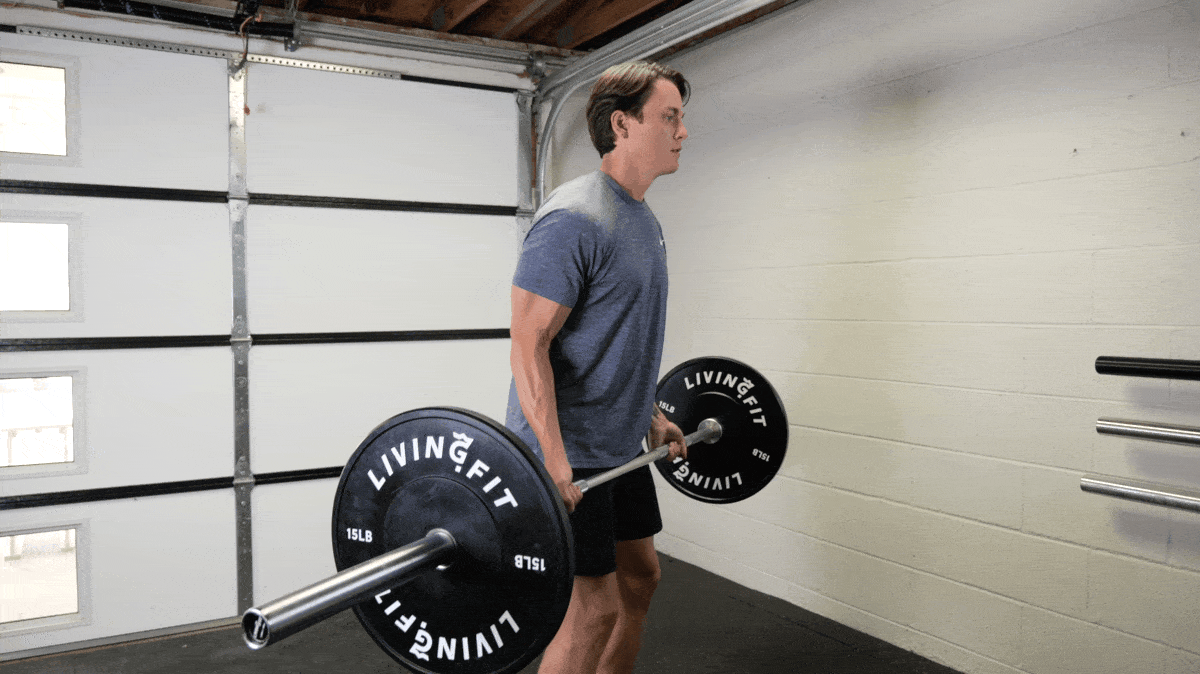
| Equipment Needed | Barbell, weight plates, wrist wraps (optional) |
| Muscles Worked | Biceps |
| Sets & Reps | 3 x 8 |
The main benefit of the barbell curl is that it allows you to lift more weight as you’re standing and curling a single implement with two hands. Barbell curls are simple, straightforward, and allow you to place a high amount of tension on your arms. If the standard barbell curl is painful for you, try working with an ez-bar instead.
How To Do It
- Load a barbell up with a weight that you can curl comfortably with good form (meaning you’re not using momentum to cheat the weight up).
- Grip the middle of the bar so that your hands are angled in.
- Keep your arms at your sides and flex your elbows to curl the weight up towards your shoulders.
- Lower the weight back down so that your arms are fully extended with control.
Modifications
- Make It Easier: Get ahold of a cambered EZ-bar to reduce wrist strain.
- Make It Harder: Wrap a pair of towels around the bar to thicken the shaft and increase the demand on your grip.
2. Hammer Curl
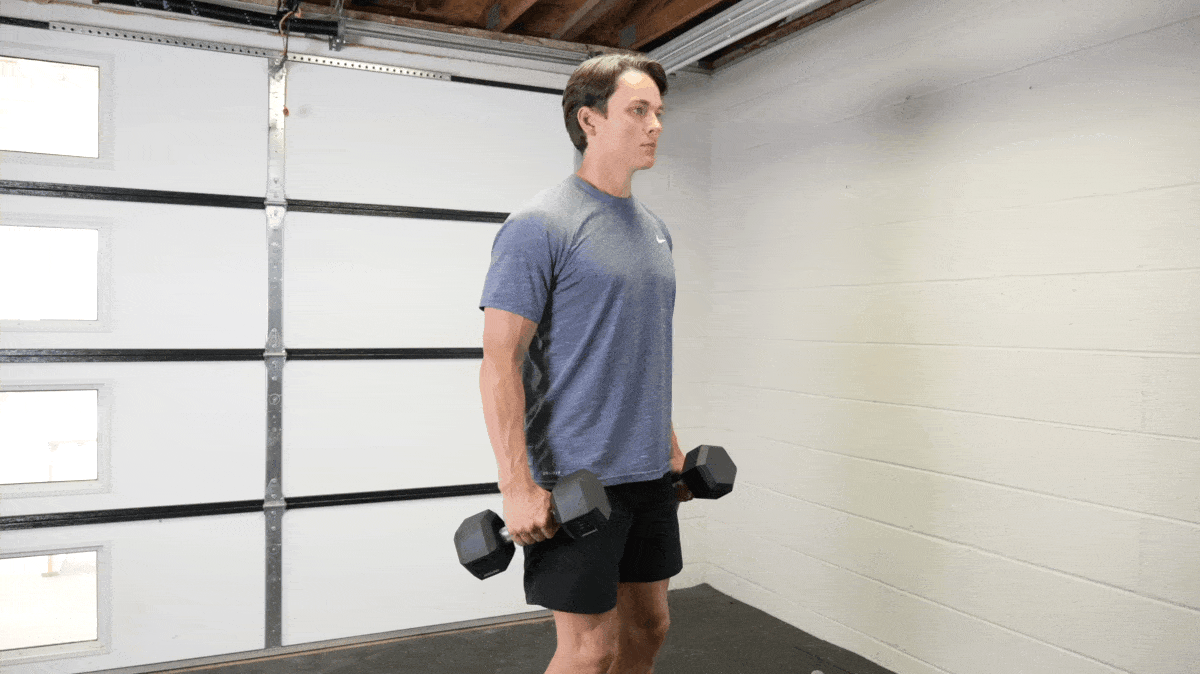
| Equipment Needed | Dumbbells |
| Muscles Worked | Brachialis, forearms, biceps |
| Sets & Reps | 3 x 8-10 |
[Read More: The Best Adjustable Dumbbells]
The hammer curl has you curl two dumbbells with your palms facing one another. This curl variation targets the brachialis, which sits underneath the biceps and makes your arms look thicker from the front.
How To Do It
- Hold a dumbbell in each hand, and make sure that your palms are facing one another.
- Keep your chest up, and curl the weights up towards your shoulders, bending your elbows until your arms are at a 90-degree angle.
- Lower the weights back down under control.
Modifications
- Make It Easier: You can do this movement while sitting down if needed.
- Make It Harder: Pause at the top of each rep once your arm is at 90 degrees.
3. Cable Curl
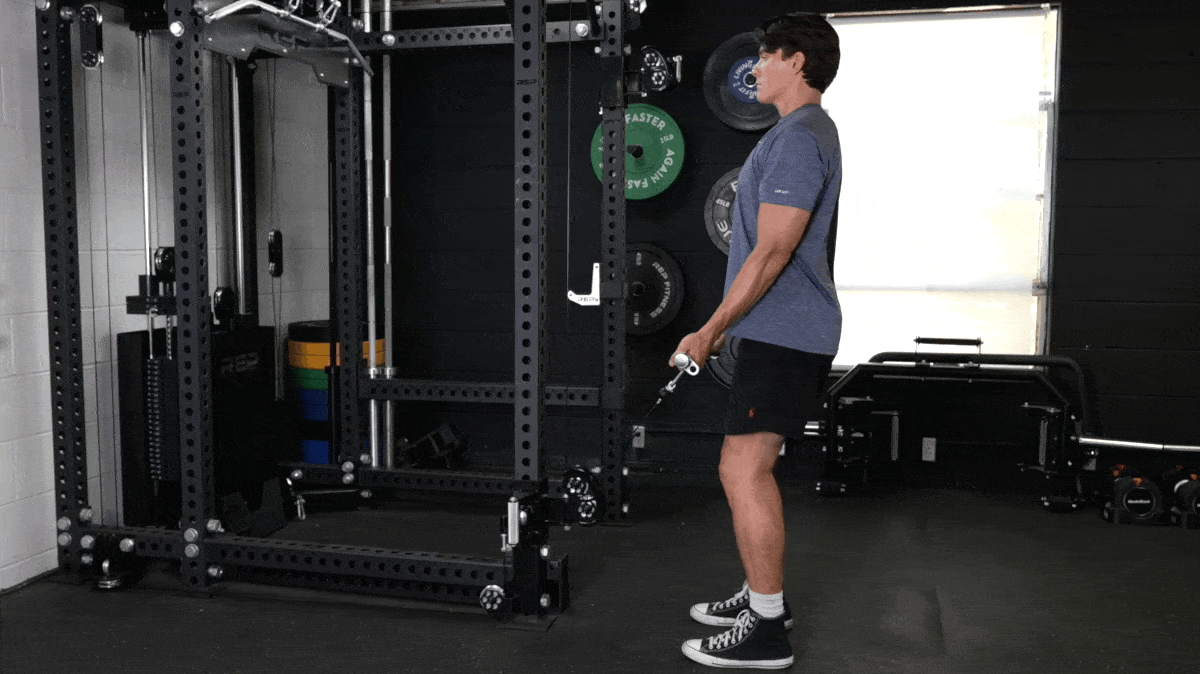
| Equipment Needed | Adjustable cable station, straight bar attachment, wrist wraps (optional) |
| Muscles Worked | Biceps |
| Sets & Reps | 2-3 x 10-12 |
When you curl a dumbbell or barbell, it becomes easier at the top and bottom of the exercise, since the weight is closer to your body. A cable is heavy throughout the entire range of motion of a curl.
We think highly of the straight bar attachment for this move because it fully supinates your wrist, putting the biceps in a great position to work. However, if you experience wrist pain or discomfort, you can do cable curls with a rope or cambered bar attachment as well.
How To Do It
- Set a cable pulley to the lowest point of the machine and attach your bar of choice — a straight bar, ez-bar, and rope are all standard options.
- Select a moderate weight, and grab the handle in both hands.
- Take a few steps back so that the weight stack is suspended and the cable is taut.
- Slowly curl the bar up towards your shoulders and lower the bar back down with control.
Modifications
- Make It Easier: You can lie down on the floor on your back and curl “horizontally” to make things more stable.
- Make It Harder: Cable curls are excellent candidates for drop sets.
4. Preacher Curl
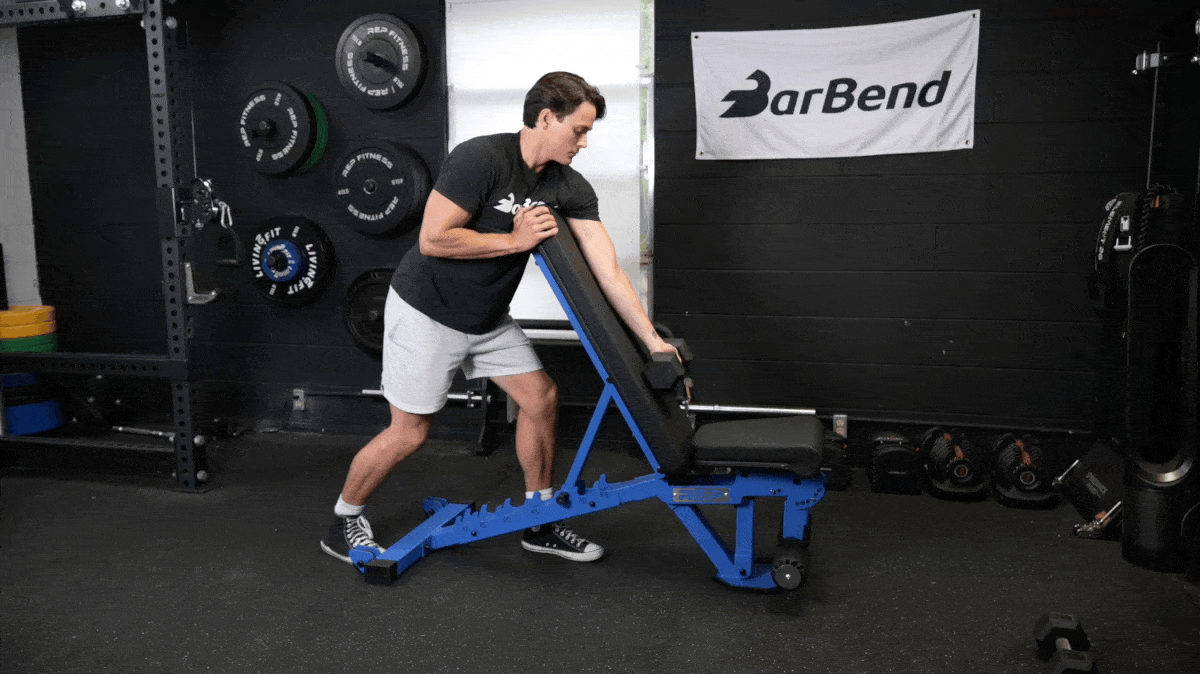
| Equipment Needed | Preacher bench or adjustable weight bench, barbell or dumbbell(s) |
| Muscles Worked | Biceps |
| Sets & Reps | 2-3 x 8-12 |
A good biceps exercise should isolate your biceps, and the preacher curl does just that. By placing the back of your arm against a stable surface, you remove the possibility of cheating your form with momentum.
We’re a fan of the standard barbell preacher curl, but you might not have a preacher bench at your disposal when you train. Grab an adjustable bench and a dumbbell — there’s no reason you can’t do your preacher curls with one arm at a time.
How To Do It
- Set an adjustable weight bench to a high incline and wedge your armpit into the top of the seat while holding a dumbbell.
- Stagger your stance to brace your body against the bench.
- Start with your forearm pointed toward the ceiling and gradually open your elbow.
- Lower the weight until the back of your hand barely touches the bench, then curl it back to the starting position.
5. Chin-Up
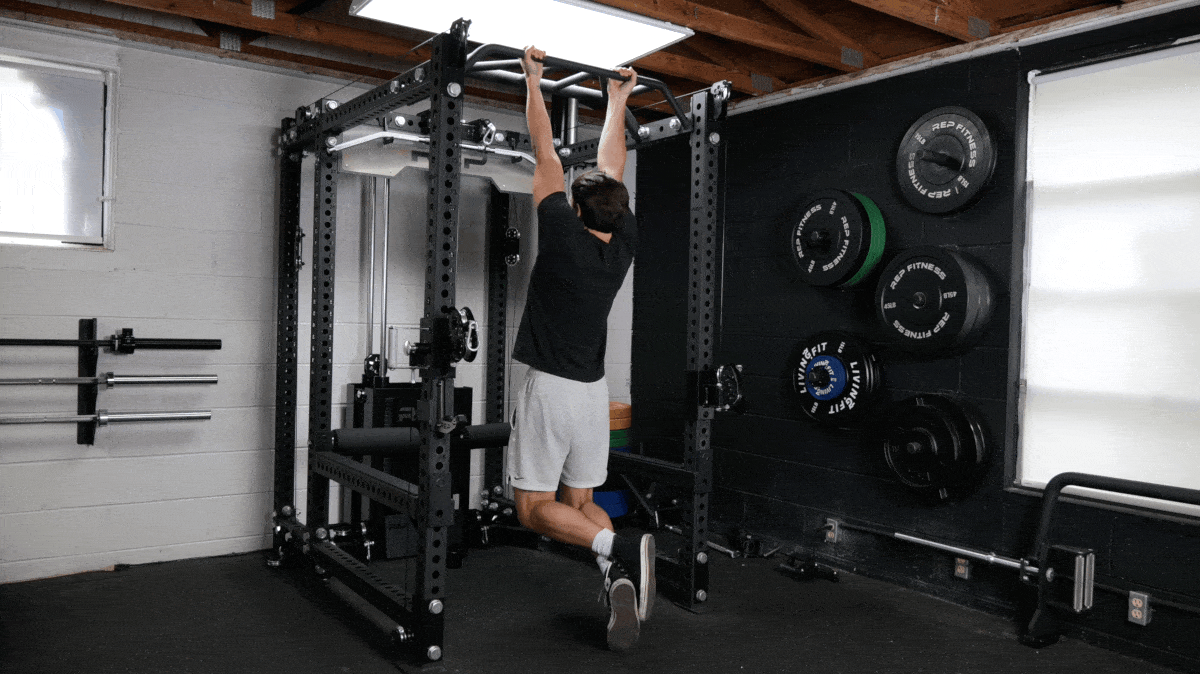
| Equipment Needed | Pull-up bars, plate-loaded belt (optional) |
| Muscles Worked | Lats, biceps, upper back, forearms |
| Sets & Reps | 2-3 x 12+ |
The chin-up is known for its back-building benefits, but the biceps are a crucial player in this exercise, too. As a bonus, you don’t need any equipment other than a stable bar to perform chin-ups, making them a convenient at-home arm exercise as well.
How To Do It
- Grab onto a pull-up bar with an underhand grip and let your body hang with your arms fully extended.
- Squeeze your shoulder blades together and pull your body up, leading with your elbows.
- Keep pulling until your chin is at or above the bar, lower yourself back down under control.
Modifications
- Make It Easier: Tie a resistance band to the pull-up bar and loop the free end under your feet to give you some extra help if you can’t perform unassisted chin-ups yet.
- Make It Harder: Load up by wearing a plate-loaded dip belt or holding a small dumbbell between your ankles.
6. Skull Crusher
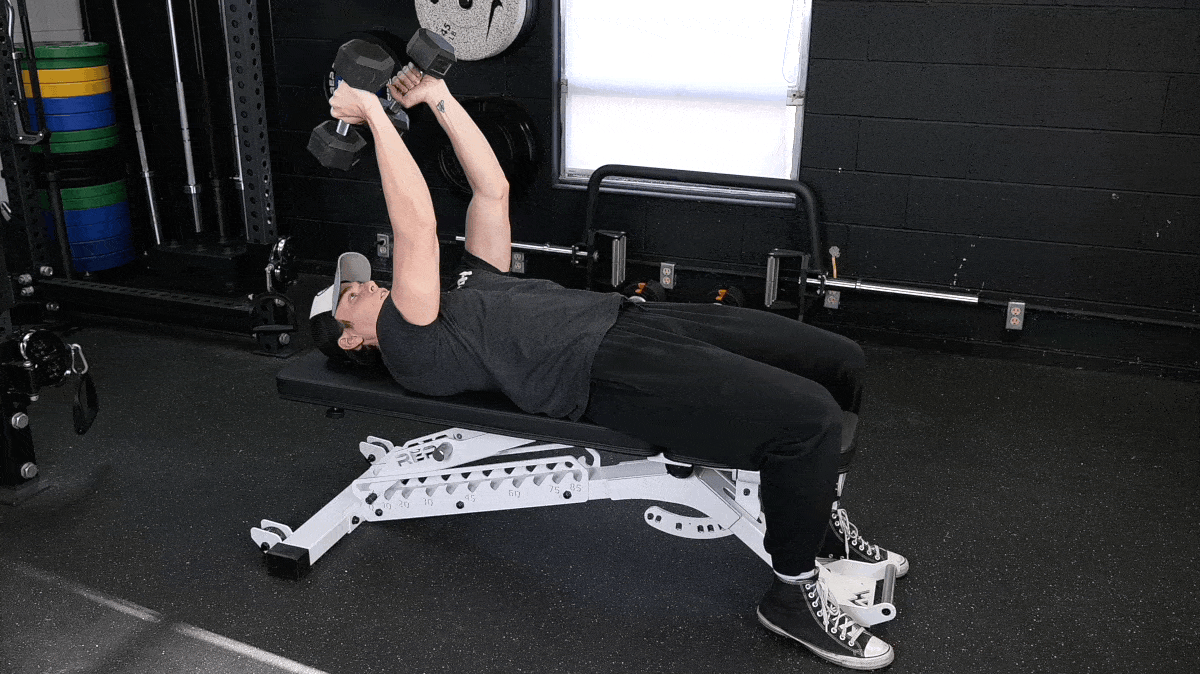
| Equipment Needed | Barbell or cambered bar, weight plates, or dumbbells |
| Muscles Worked | Triceps |
| Sets & Reps | 2-3 x 10-12 |
While you can do this move with a variety of equipment, we prefer the dumbbell skull crusher since it allows you to isolate each arm. This lets your weaker side play catch-up if you have an imbalance. You can also perform these with your palms up or facing each other, which is usually more comfortable for your wrists. The skull crusher isn’t a new triceps exercise, but it’s one of the best muscle-building arm workouts out there for your ‘tris.
How To Do It
- Pick up two light to moderate dumbbells and lay down, back first, on a weight bench with your feet firmly planted on the floor.
- Raise both dumbbells over your chest, arms fully extended and palms facing each other.
- Flex at the elbows to lower the dumbbells toward your forward and to the top of your shoulders.
Modifications
- Make It Easier: Perform this move on the floor to ensure your shoulders don’t drift too far behind your head.
- Make It Harder: Set the bench to a very slight incline to further stretch your triceps.
7. Dip
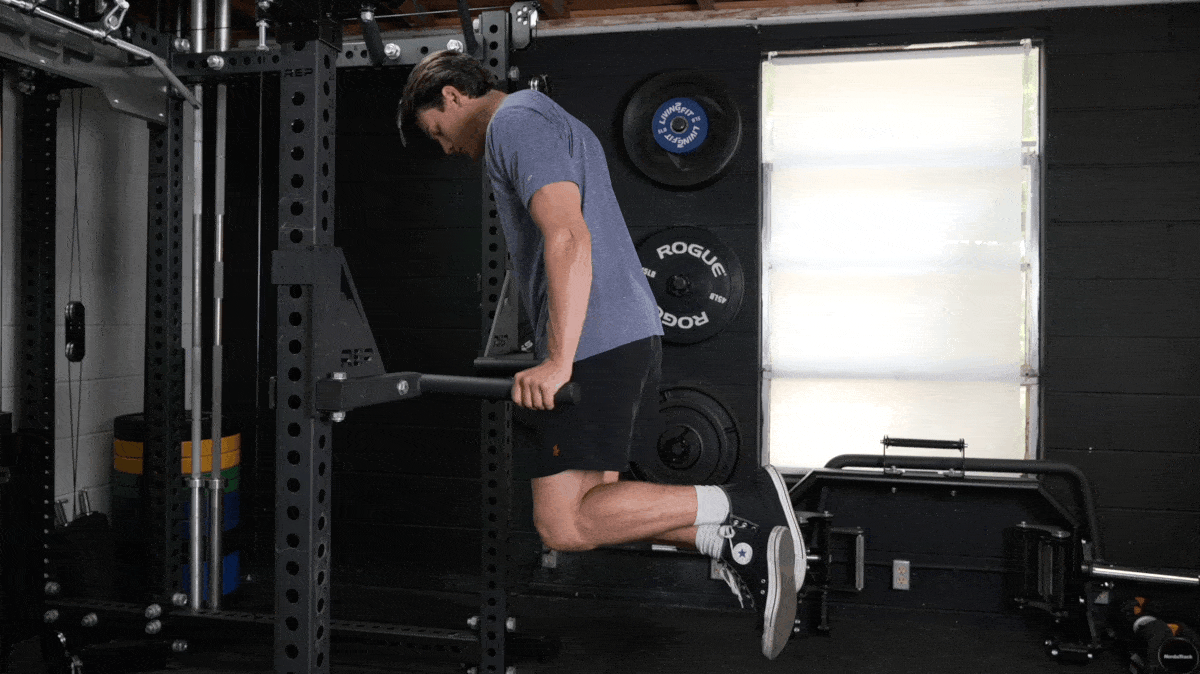
| Equipment Needed | Dip bars, weight belt (optional), dumbbell (optional) |
| Muscles Worked | Triceps, shoulders, chest, core |
| Sets & Reps | 2-3 x 10+ |
The dip is lauded for its ability to add muscle all across your upper body. Your core gets a workout, too, as you work to stabilize yourself while suspended in the air. Similar to the chin-up, this bodyweight exercise forces you to move your entire weight with just your triceps. Dips make for a great workout finisher at the end of an arm day.
How To Do It
- Suspend yourself between two parallel bars, with your elbows locked out.
- Get stable and then bend your elbows to lower your body down until your arms are bent at 90 degrees.
- Keep your chest up and your body straight to work your triceps more than your chest. Press back up.
Modifications
- Make It Easier: If you can’t do suspended dips yet, do chair dips instead with your feet on the ground in front of you.
- Make It Harder: Add weight via a dip belt or dumbbell, or pause in the bottom of each rep.
8. Cable Triceps Pushdown
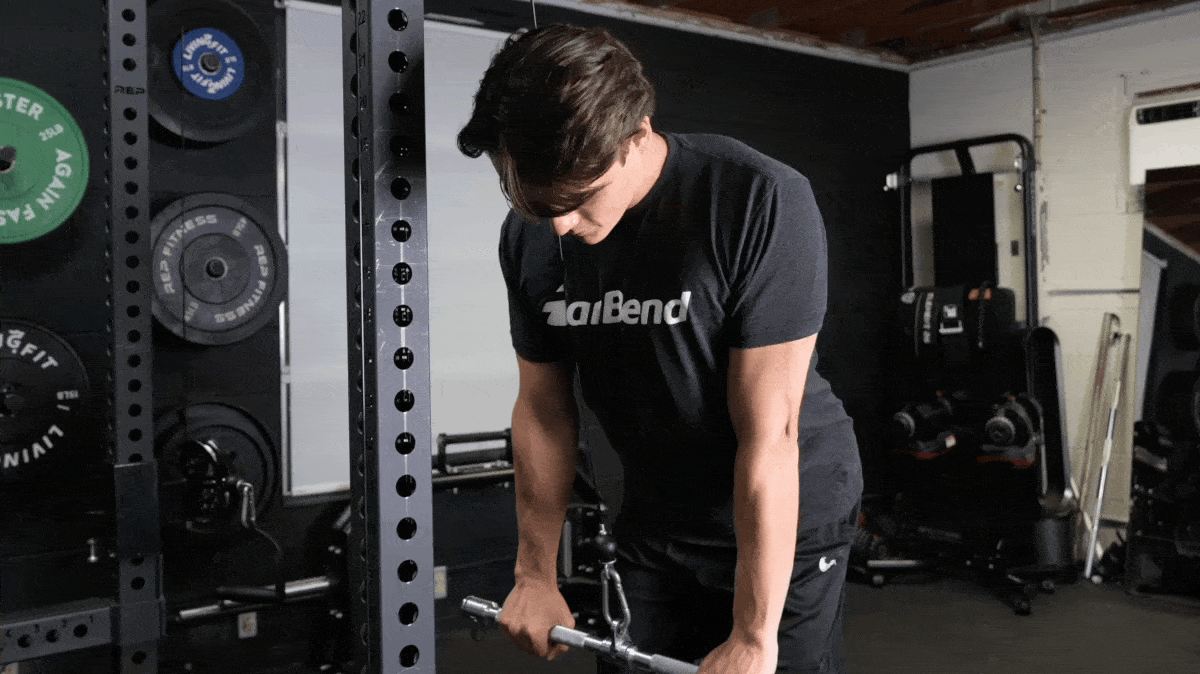
| Equipment Needed | Cable station, attachment of choice |
| Muscles Worked | Triceps |
| Sets & Reps | 2-3 x 8-12 |
We don’t need to sell you on the triceps pushdown — it’s a classic. By pushing an attachment down with just your triceps, you can fully isolate the area. The cable also keeps constant tension on the muscle, and you can attach a variety of handles for a varied grip to better feel the contraction or alleviate elbow or wrist pain.
How To Do It
- Set a cable pulley to the highest setting and attach your handle of choice — a straight bar, ez-bar, rope, or D-handle.
- Grab it with both hands and stand about a foot or so away from the cable machine.
- Flex your elbows to push the bar down until your arms are fully extended.
- The handle should be at your hips. Slowly lower the weight back to the starting position.
Modifications
- Make It Easier: Try one-arm pushdowns with a D-handle attachment.
- Make It Harder: Try one-and-a-half reps, doing an extra rep of the first half of the range of motion between your full reps.
9. Overhead Triceps Extension
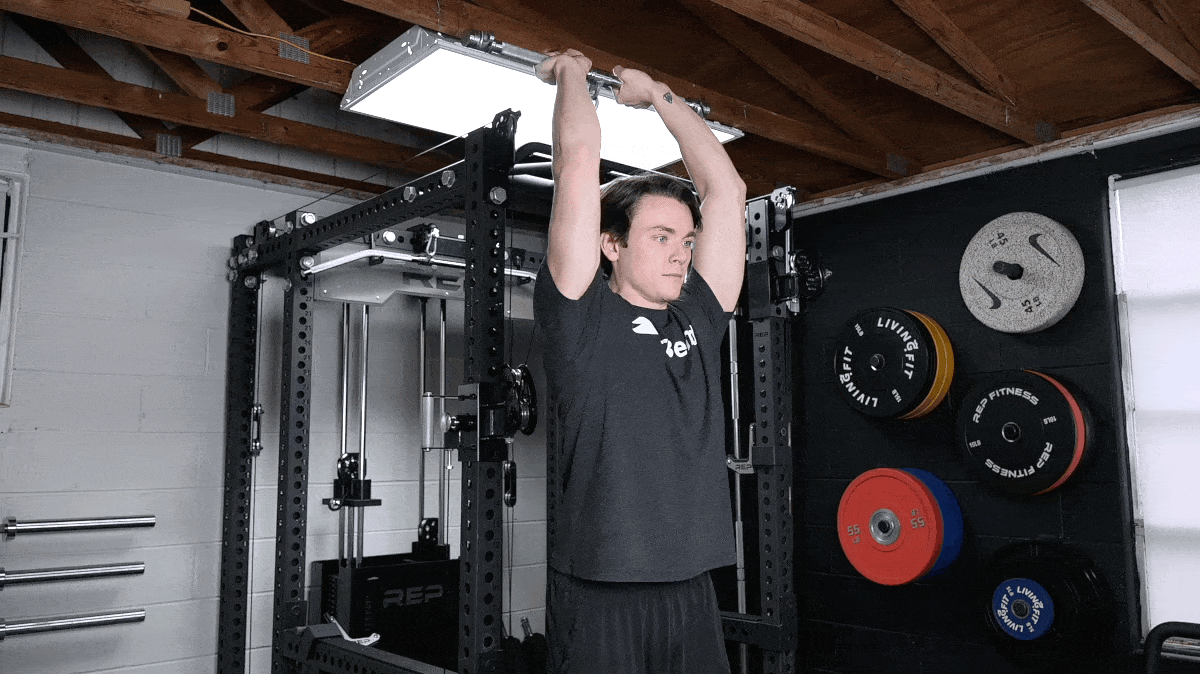
| Equipment Needed | Cable station, attachment of choice |
| Muscles Worked | Triceps |
| Sets & Reps | 2-3 x 12-15 |
[Read More: The Best Arm Exercises for CrossFitters]
The long head of your triceps muscle crosses both your elbow and shoulder joint. If you want to train this part of your arm for complete triceps development, you’ll need to do at least one movement with your arm up behind your head, since this posture stretches the long head fully.
The overhead triceps extension is the gold standard here, and is one of the best under arm exercises you can do as well. If you don’t have access to an adjustable cable station, you can also do this move by standing on a long resistance band.
How To Do It
- Set a cable pulley with the attachment of your choosing to around waist height.
- Grab the attachment and take a step back to pull the cable taught.
- Twist around so your arms come up behind your ears and the cable is pulling down behind you. Your elbows should be pointing up towards the ceiling.
- Brace your core and then extend your arms by contracting your triceps until your arm points fully upwards.
Modifications
- Make It Easier: Set the cable to eye level and stand facing away from it, extending your elbow by “pointing” the cable attachment directly forward.
- Make It Harder: Pause in the stretched position of each repetition.
10. Wrist Curl
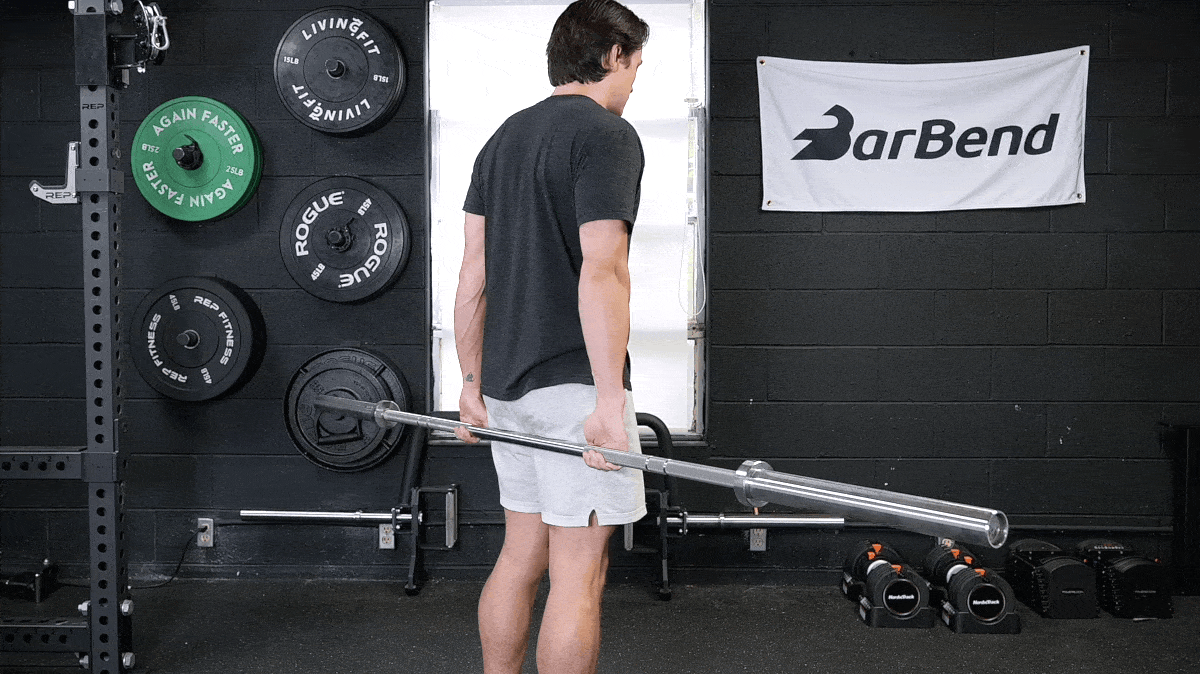
| Equipment Needed | Barbell or dumbbells |
| Muscles Worked | Forearms |
| Sets & Reps | 2-4 x 15-20 |
There are muscles below your elbow — we know, you’re shocked. But your forearms deserve attention just like your biceps and triceps. Wrist curls are one of the best forearm exercises you can do to beef up that area and strengthen your joints as well. They’re also accessible and easy to perform in a hurry.
How To Do It
- Stand upright while holding a barbell behind your back with an overhand grip.
- Allow the barbell to drift down into your fingertips.
- Curl your fingers, bringing the bar back into your palm, then curl your wrist until your knuckles are pointing upward toward the ceiling.
5 Arm Workouts To Incorporate
A pair of big arms can do a lot more for you than just grabbing attention at the beach. From bear hugs to bench press competitions, your biceps and triceps are involved in almost everything you do in and out of the gym.
While some will puff their chests and declare that they built their arms with pull-ups, presses, or — somehow — squatting, most lifters who have been in the game awhile will concede that if you want big arms, you have to train for big arms.
Arm Workout for Size
These exercise selections are well-rounded suggestions, but remember that bodybuilding is highly individual. If you struggle to elicit a good contraction with an exercise, don’t force a square peg into a round hole. Substituting exercises that don’t serve you well can potentially spare you injury and keep you on the fast track to progress.
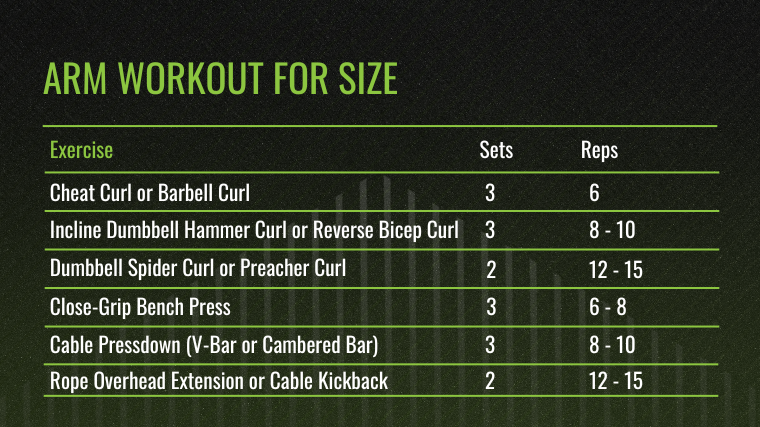
- Cheat Curl or Barbell Curl: 3 x 6
- Incline Dumbbell Hammer Curl or Reverse Bicep Curl: 3 x 8-10
- Dumbbell Spider Curl or Preacher Curl: 2 x 12-15
- Close-Grip Bench Press: 3 x 6-8
- Cable Pressdown (V-Bar or Cambered Bar): 3 x 8-10
- Rope Overhead Extension or Cable Kickback: 2 x 12-15
[Read More: Best Kettlebells]
Arm Workout for Strength
The two main factors when integrating arm work into a strength routine are 1) the exercises should complement your primary lifts or activities, and 2) the training should not hamper your performance elsewhere. As such, perform this workout on its own day or after your primary training, and don’t be afraid to adjust volume as needed.
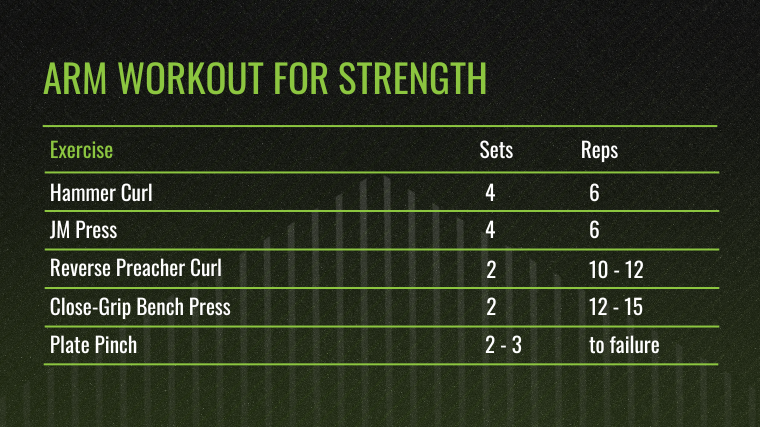
- Hammer Curl: 4 x 6
- JM Press: 4 x 6
- Reverse Preacher Curl: 2 x 10-12
- Overhead Rope Extension: 2 x 12-15
- Plate Pinch: 2-3 sets to failure
Arm Workout for Beginners
For exercise newbies, one of the best things about your training “economy” is your rate of return. In simple terms, this means that first-timers can get a lot out of a little. More volume and intensity will be required with more years of training under your lifting belt, but beginner programs should be lean and mean.
Perform this workout once per week to start, adding weight or reducing rest times as it gets easier.
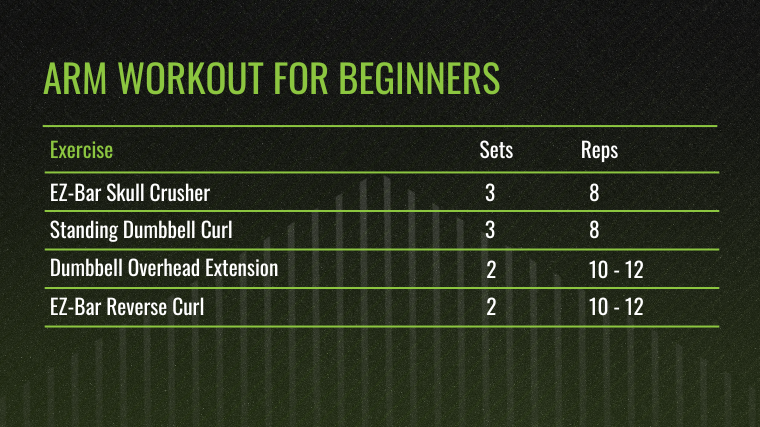
- EZ-Bar Skull Crusher: 3 x 8
- Standing Dumbbell Curl: 3 x 8
- Dumbbell Overhead Extension: 2 x 10-12
- EZ-Bar Reverse Curl: 2 x 10-12
Arm Workout for Weightlifters
Elbow stability is a critical element of weightlifting, both in training and during competition. Contrary to popular belief, bulging biceps don’t interfere with your ability to fully extend the elbow, as long as your triceps training is proportional and you stretch regularly.
Further, diligent accessory training may help diminish elbow and shoulder pain, both of which commonly plague Olympic lifters and can interfere with programming if left unaddressed.
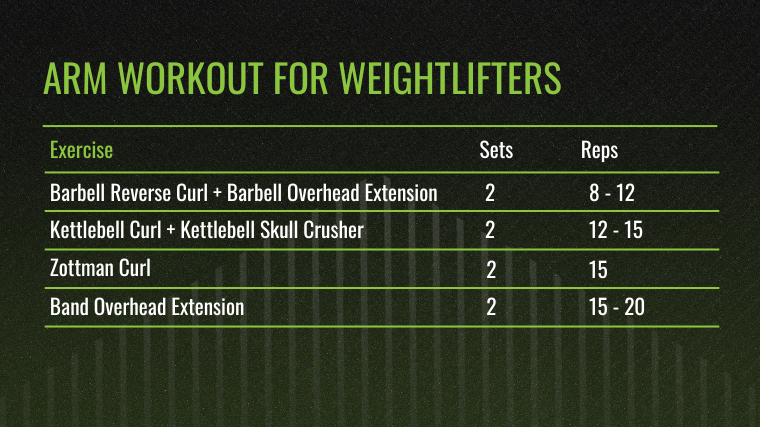
- Barbell Reverse Curl + Barbell Overhead Extension: 2 x 8-12
- Kettlebell Curl + Kettlebell Skull Crusher: 2 x 12-15
- Zottman Curl: 2 x 15
- Band Overhead Extension: 2 x 15-20
[Read More: The Best Arm Exercises for Weightlifting]
Bodyweight Arm Workout
When it comes to calisthenics training and muscle growth, the key is leverage. More specifically, compromising your leverage as much as possible, so you’re utilizing as much of your own weight as you can for a sort of pseudo-overload.
Hit this workout twice per week to start, focusing on reducing rest times and stressing your eccentric tempo to drive progress. We’ve included both a beginner and advanced option so you can tailor your training specifically to your fitness level.
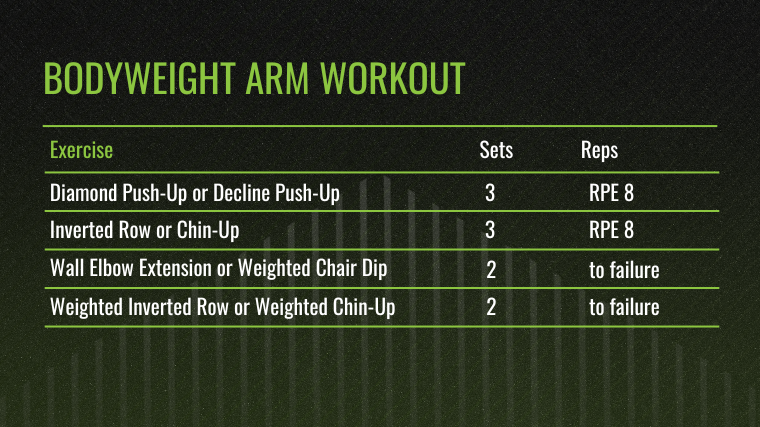
- Diamond Push-Up or Decline Push-Up: 3 x RPE 8
- Inverted Row or Chin-Up: 3 x RPE 8
- Wall Elbow Extension or Weighted Chair Dip: 2 sets to failure
- Weighted Inverted Row or Weighted Chin-Up: 2 sets to failure
Benefits of Training Arms
As we speak, thousands of gym rats are hard at work in the free weight section, hammering away at various upper arm exercises or muscle-building arm workouts. Why? Because arm training is the bee’s knees. Here are just a few of the many benefits of working out your arms in the gym:
Easy To Do
Arm training is pretty straightforward. You don’t need to learn too many complicated exercises or overdo it in the programming department — a few of your favorite curls and extensions will do wonders for your arms if you work hard.
We think that, when it comes to arm training, more is (usually) more. Science supports this idea, too; one study found that high-volume arm training (5+ sets per workout) provided more muscle gain than doing low or moderate volumes. (1)
[Read More: Arm Exercises You’ve Never Tried Before]
Working out properly shouldn’t necessarily be easy, but we believe that your training should have low barriers to entry. Arm exercises shine here. You can, quite literally, grab and go.
Supports Other Exercises
You need your arms for more than looking good at the beach. If you want to develop your upper body strength — whether you’re doing dumbbell exercises, working with the barbell, or even prefer to use your own bodyweight — your arms shouldn’t be a sticking point.
[Read More: Arnold Schwarzenegger’s Arm Workout, Explained and Remixed for All Experience Levels]
Strengthening your biceps with curls and your triceps with pressdowns or extensions will ensure that those muscles can contribute sufficiently to compound exercises like the row or bench press. Strong arms also help you perform more chin-ups, dips, and basically any other movement involving your upper half.
Build Strength and Size
This isn’t unique to arm exercises, but the accessibility of most biceps and triceps moves means you can work on multiple dimensions of fitness at once. Case in point: Studies show that you can build muscle mass while working across a variety of rep ranges. (2)
[Read More: Try These 6 Unique Bodybuilding Arm Exercises to Spark New Muscle Growth]
We love isolation moves (that is, exercises involving motion at only one joint) here, since you can perform a lot of repetitions quickly without your technique deteriorating too much. Want to lift heavy and build strength? There are arm exercises for that, too — cheat curls, weighted dips or skull crushers, and so on.
Muscles That Make Up the Arms
Our fellow gym rats know exactly what the major arm muscles are. After all, we’ve all spent plenty of time flexing in the mirror after catching a good pump. But there’s a bit more to your arm anatomy than just your biceps and triceps. Here’s what you need to know:
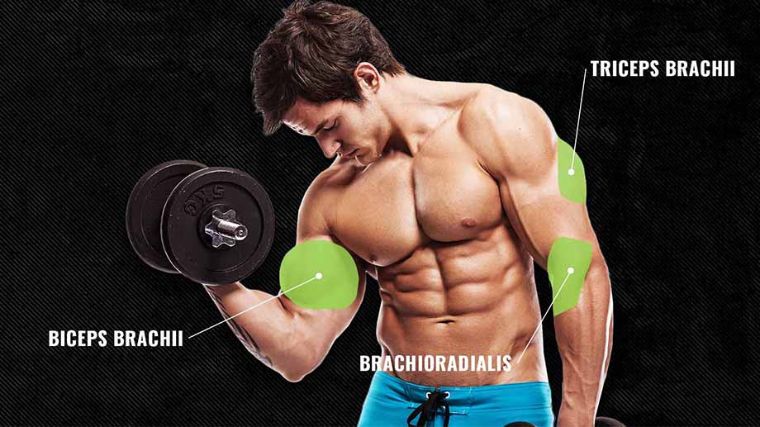
[Related: What’s the Average Biceps Size and How Do You Stack Up?]
- Biceps Brachii: This muscle sits on the front of your arm, but connects from your forearm to your shoulder blade. The biceps primarily perform elbow flexion (think any curling motion).
- Brachialis: This muscle sits underneath and adjacent to the biceps brachii and connects from your upper arm bone to your forearm. Your brachialis assists your biceps with elbow flexion, and will actually take over almost entirely if you perform curls with a neutral, straightened wrist.
- Triceps Brachii: This three-headed muscle lies on the back of your upper arm. Your triceps actually make up about two-thirds of the overall muscle mass in your arm, and their primary function is to extend your elbow when your arm is tucked to your side or held above your head.
- Brachioradialis & Forearms: The brachioradialis is a wrist extensor and sits just below your elbow joint. When you bend your wrist backward, you’ll see it. This muscle, along with the dozens of other smaller tissues in your hand and forearm, control the many delicate movements of your wrist and hand.
References
- Schoenfeld BJ, Contreras B, Krieger J, et al. Resistance Training Volume Enhances Muscle Hypertrophy but Not Strength in Trained Men. Med Sci Sports Exerc. 2019;51(1):94-103. doi:10.1249/MSS.0000000000001764
- Schoenfeld BJ, Grgic J, Ogborn D, Krieger JW. Strength and Hypertrophy Adaptations Between Low- vs. High-Load Resistance Training: A Systematic Review and Meta-analysis. J Strength Cond Res. 2017 Dec;31(12):3508-3523. doi: 10.1519/JSC.0000000000002200. PMID: 28834797.
Featured image: Microgen / Shutterstock